Daily standups are short meetings that help agile teams share progress, discuss blockers, and get on the same page. In 10-15 minutes, everyone has to answer three questions:
- What did you do yesterday?
- What will you do today?
- Anything blocking your progress?
Daily standups (sometimes called daily huddles or daily scrum meetings) are deceptively simple. After all, what could be so hard about running a quick meeting where people have to answer three simple questions?
As it turns out lots of issues can crop up during a daily standup — from unprepared participants to constant interruptions and irrelevant discussions. In this article, we’ll discuss those mistakes, as well as the best practices you can apply to avoid them.
However, a quick note before we dive in:
Traditional synchronous daily standups — i.e., in-person meetings or video calls — have some inherent downsides that can’t be entirely avoided.
Specifically, synchronous standups can:
- Disrupt productivity.
- Create scheduling difficulties for distributed teams.
- Force participants to sit through updates that aren’t relevant to their work.
In the second part of this article, we’ll discuss these downsides in more detail and show you how to avoid them with faster and less-disruptive asynchronous standups.
Here’s everything we’ll cover below:
- How to run agile daily standups: 6 mistakes to avoid and best practices
- The downsides of traditional agile daily standups
- How to run fast, effective, and less disruptive asynchronous daily standups with Geekbot
Note: If you want to try running asynchronous agile daily standups in Slack or MS Teams, create a free Geekbot account. For more details on the most common daily standup mistakes, as well as the downsides of traditional standup meetings, read on.
How to Run Agile Daily Standups: 6 Mistakes to Avoid and Best Practices
While standups initially gained traction among product and software development teams, today they’re very popular with other departments like marketing, user experience, and customer success.
Despite this popularity, many teams still make some crucial mistakes when running their standups. These mistakes can turn standups into a repetitive chore, rather than a productive team check-in.
Here are the 6 most common daily standup mistakes and how to avoid them:
Mistake #1: Not Preparing Ahead of Time
The simplicity of daily standups easily fools participants into thinking they don’t have to prepare for them. However, people who haven’t prepared their answers can easily draw a blank when it’s their turn to speak.
As a result, others have to wait while the participant pulls up their tasks or tries to remember what they wanted to say. Plus, it’s also easy to forget important updates if you didn’t write them down beforehand.
Best practice: Set aside five minutes before the daily standup to jot down your updates. Even better, have the entire team do this so that the standup goes as smoothly as possible.
Mistake #2: Allowing the Meeting to Start Late
In order for standups to be effective, everyone needs to view them as a priority, not an optional status update. This can’t happen if participants consistently come late and disrupt the meeting’s flow. Additionally, when people are late, crucial information falls through the cracks, preventing the team from getting aligned.
Best practice: Constantly reinforce the importance of being punctual by starting the meeting on time, regardless of who’s present or not.
Mistake #3: Letting the Meeting Run Too Long
The 15-minute timebox is one of the best attributes of the daily scrum meeting — it’s long enough for 5-8 people to give their updates, but short enough so they don’t get bored.
If your daily standups get into the habit of running late, you get all sorts of cascading issues. For example, some people may stop keeping their updates concise or relevant because they know there’s a safety net.
This can even turn your standups into chit-chat or storytelling sessions. While it’s great to encourage light-hearted discussions at work, the daily standup is not the place for them.
Best practice: End the meeting after 15 minutes, regardless of who’s had a chance to speak. However, if a standup takes too long despite people keeping their updates concise, it may be time to split it into multiple standup meetings based on teams or projects.
Mistake #4: Not Being Focused on Others’ Updates
As with all meetings, it’s easy to get distracted during your standup even though it’s only 15 minutes long. Slack messages, email, social media, and phone calls can all disrupt concentration.
These distractions can quickly ruin the whole point of the standup. When people are distracted, they miss important updates. When they miss important updates, the team stops being aligned, so the meeting’s whole purpose is defeated.
Best practice: Block all possible distractions during your standups — keep your phone away, close Slack, minimize your browser, and just be present. This is easier said than done, but it will become natural after some practice.
Mistake #5: Starting Long Discussions about Blockers or Other Issues
The most discussed items of a daily standup are usually the blockers because participants are usually eager to get their issues out there. This is an essential outcome of the daily standup that should be encouraged.
What shouldn’t be encouraged, however, is discussing how to resolve roadblocks during the standup. When that happens, two people usually take over the whole meeting, while everyone else loses interest and/or gets annoyed.
Best practice: Remember that standups aren’t problem-solving sessions. The meeting facilitators should cut off any problem-solving discussions early and ask the participants to come back to it at a later time.
Mistake #6: Letting Your Standups Get Stale
Even with great organizational rules, the team can easily become uninterested because daily standups can get repetitive.
This can be a tricky problem because you need to switch things up in order to keep your standups interesting. But at the same time, you don’t want to disrupt the meeting too much by changing its focus.
Here are two best practices for introducing variety into your standups:
- Change your standups’ frequency. Holding standups every day isn’t the only way to go. You can try having them only on selected days, like Mondays and Fridays. This can help reduce the dreaded Zoom fatigue that’s so prevalent among remote teams. You can also change when your standups take place, e.g., at lunch, instead of in the morning.
- Add one more question. For example, you can try some light-hearted icebreakers like “What did you have for breakfast?” or “Coffee or tea?”.
If you want more ideas for switching up your daily standups, check out our article on the 7 fun standup meeting ideas.
The Downsides of Traditional Agile Daily Standups
While useful, synchronous daily standups have some inherent limitations, which cause lots of headaches for scrum teams. Specifically, daily standup meetings:
- Are difficult to schedule for remote teams spread across the globe. Say you have team members in San Francisco, Sydney, and Delhi. Finding a good time for the standup can be impossible. As a result, some team members have to come very early in the morning, late at night, or at other inconvenient times.
- Require participants to listen to updates that don’t concern them. During larger standups (e.g., between five and eight people), it’s natural that some participants will have to sit through updates that have nothing to do with their work. This lowers their engagement and can even lead to people perceiving the standup as a waste of time.
- Disrupt people’s workflow. In-person team meetings and video calls are inflexible because you have to stop what you’re doing to attend them. That’s often the last thing people want to do while in a flow state working on a complex task.
Back in 2014, we were a team of seven remote people running daily standups via video conferencing, so we experienced all of these issues first-hand.
Some people had to come at inconvenient times. Sometimes, our meetings would go off track and overrun by as much as one hour. In short, we learned the hard way that synchronous meetings weren’t for us.
This prompted us to adopt asynchronous, text-based standups and build Geekbot — a tool for asynchronous meetings that integrates with Slack and MS Teams.
We initially built Geekbot for internal use but decided to release it to the public in 2015. Since then, over 170,000 users, including teams from Zapier, GitHub, and Shopify have used it to run asynchronous standups and other remote work check-ins.
If you’re interested, you can check out some of their stories below:
- How GitLab uses Geekbot to run remote work check-ins
- How Zapier uses Geekbot to run asynchronous standups
- Shopify uses Geekbot to create a culture of trust among remote teams
In the next sections, we’ll show you how to run asynchronous standups via Slack or MS Teams with Geekbot.
How to Run Fast, Effective, and Less-Disruptive Asynchronous Daily Standups with Geekbot
The process of running a daily standup with Geekbot is very simple:
- You select the standup questions and the team members who will receive them.
- You choose the time and frequency at which these questions get sent.
- Participants’ answers are posted in a Slack or MS Teams channel of your choosing.
Here’s how this works in more detail.
Step 1: Choose Your Standup Questions and Participants
When using our asynchronous meeting software, you can start with a premade template or write your standup questions from scratch.
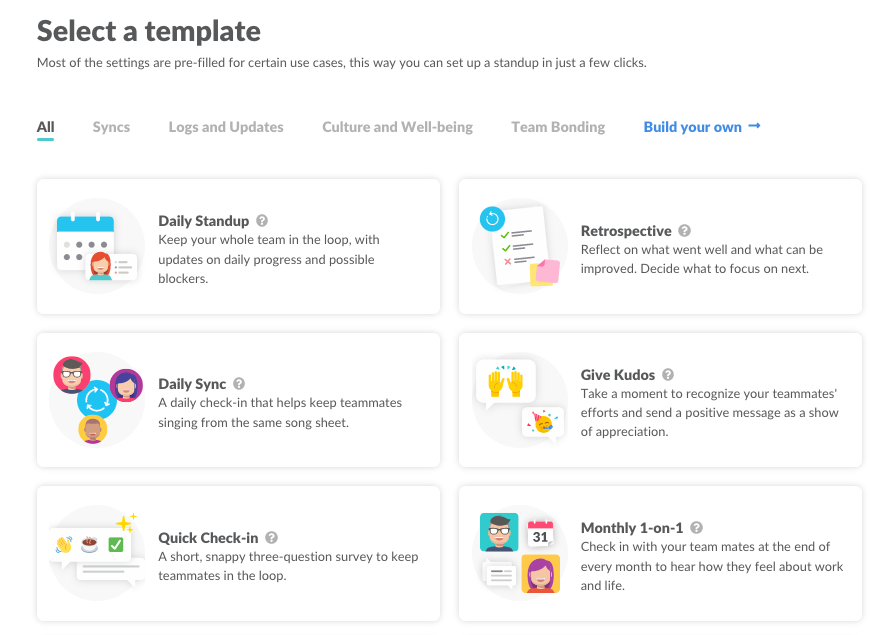
For example, the Daily Standup meeting template (top left in the screenshot above) includes four questions:
- How do you feel today?
- What did you do since {last_report_date}?
- What will you do today?
- Anything blocking your progress?
This template, like all other Geekbot templates, is fully customizable, so you can change these questions at will. For example, you can delete the first one and stick with the three classic standup questions.
Step 2: Select a Standup Schedule
Like the questions, Geekbot’s schedule is also fully customizable. For example, you can have your questions sent:
- Every morning (for a classic daily standup).
- Every afternoon (e.g., for a recap of every day).
- Twice a week (if you don’t want to run standups every day, like GitHub).
- At any other frequency that fits your needs.
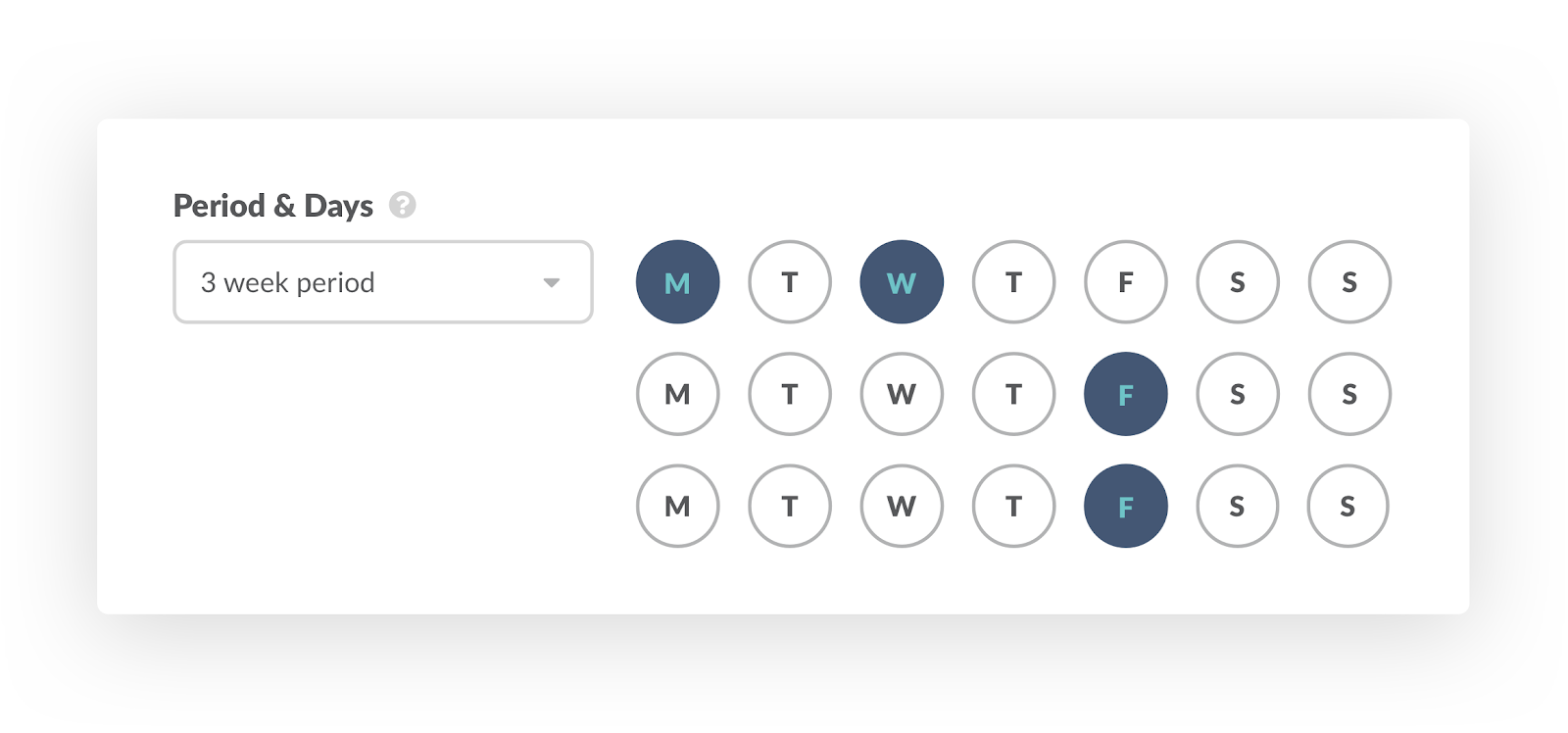
But what if you have teammates in different timezones and want them to receive their questions at an appropriate time? Simple — just enable the “User’s local timezone” option.

For example, say you want participants’ in Jakarta, Toronto, and Paris to receive their standup questions at 10:00 AM. When you enable this option, Geekbot will send everyone the questions at 10:00 AM in their timezone (instead of 4:00 PM in Jakarta and 4:00 AM in Toronto, for example).
Step 3: Collect and Review Everyone’s Responses
On the day and time you selected, Geekbot sends the standup questions to all participants via a Slack or MS Teams DM.
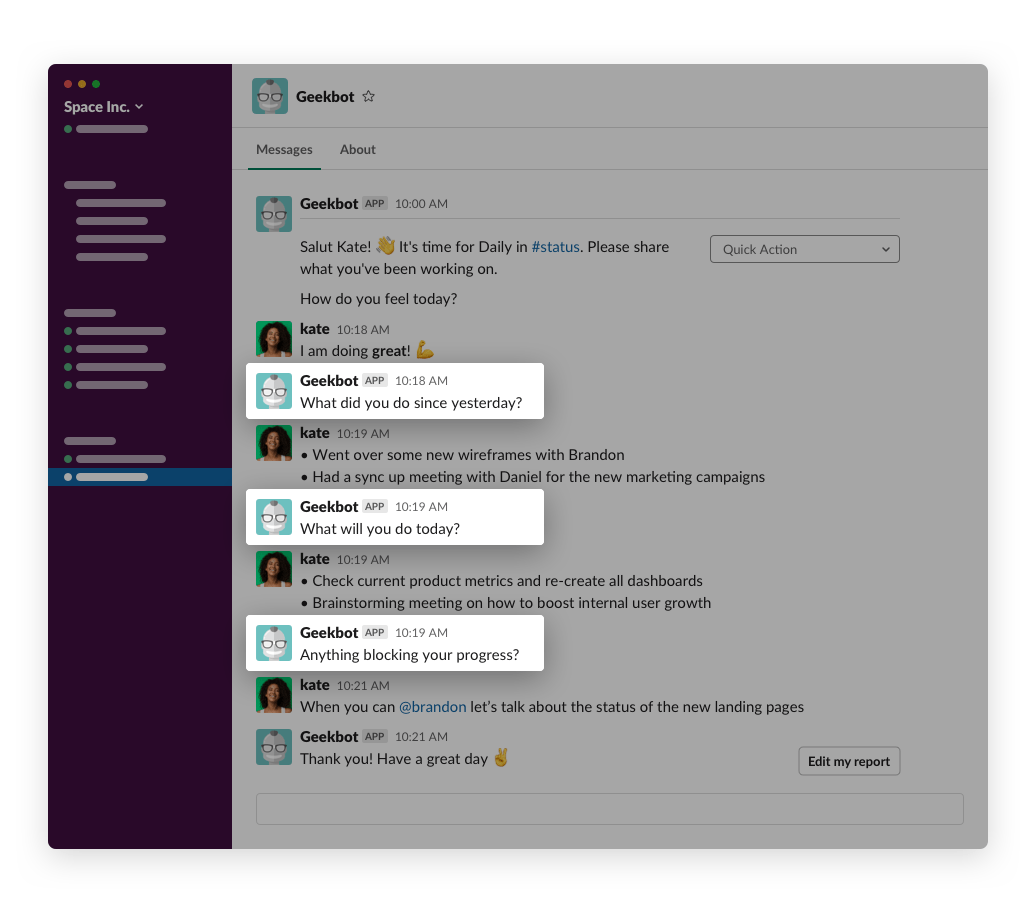
The DM acts as a prompt, so people don’t forget to send their update. Additionally, participants can answer these questions in the DM at their own convenience, without interrupting their workday.
Everyone’s answers are then posted in a channel of your choosing.

This mechanism has two crucial benefits:
- You and other participants can review the answers and quickly find the ones that are relevant to your work, instead of sitting through a meeting.
- People can discuss problems in a thread, instead of forcing the whole team to listen to their updates. For example, in the screenshot below, Kate mentioned she needed to talk to Brandon about the status of the new landing pages. Brandon then opens a thread so they can follow up and discuss the task, without distracting others.

Geekbot also gives you two other convenient ways to review people’s answers:
- The Geekbot dashboard, where you can filter based on dates, people, and more. Plus, the dashboard provides useful metrics like report streaks and participation rates.
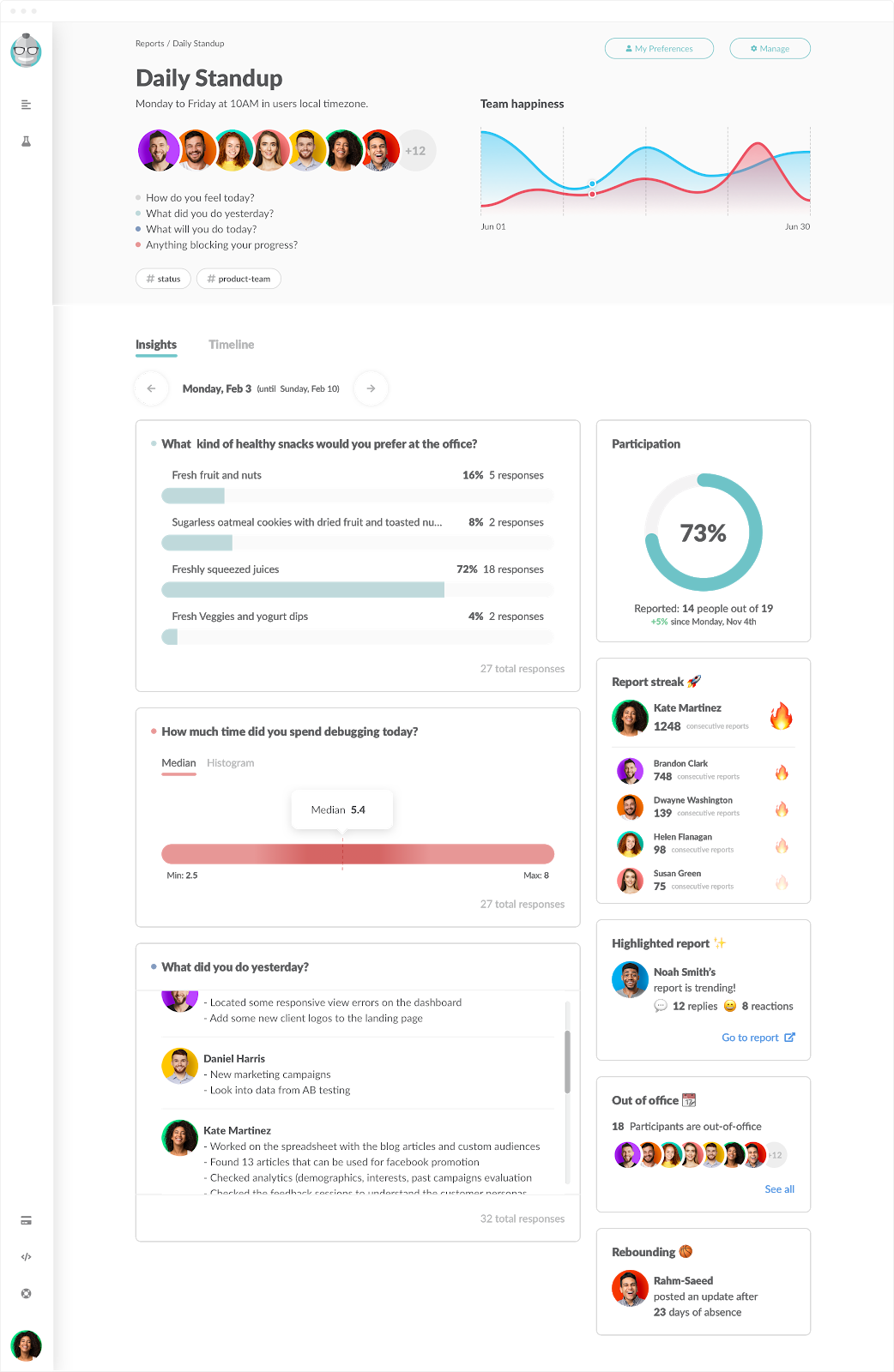
- Optional email summaries, which you can receive at a schedule that works for you (e.g., Monday mornings to recap the previous week’s tasks and progress).
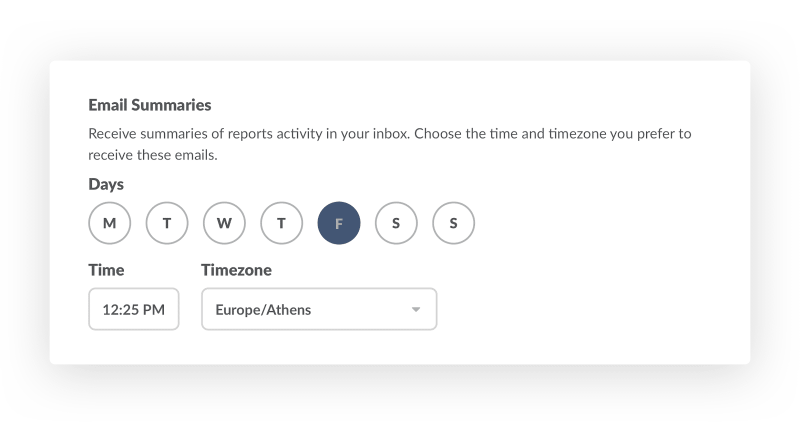
Try Geekbot for Free Today
As of this writing date, Geekbot has over 170,000 users, with a 4.9/5 rating on Capterra. Our tool is also free for teams with up to 10 active participants. For larger teams, pricing is $2.50 per active user on the annual plan and $3.00 per active user on the monthly plan.
If you want to give asynchronous standups a try and feel that Geekbot is the right fit for your needs, click here to create a free account.
You May Also Like…
- Sprint Planning & 5 Useful Tips on How to Run it
- Can’t the Scrum Master also be the Product Owner?
- Project Management Tools that Every Scrum Master Should Use
- 11 Best Software Tools for Remote Teams (Geekbot, Jira, and more)
- 4 Best Spring Retrospective Apps (whiteboards, mind maps, team analyzers, and more)
- Geekbot Integrations with Zapier (Details and Benefits)



